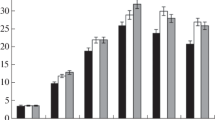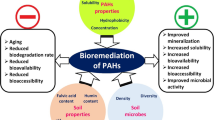Abstract
Humic acids (HA) are ubiquitous redox-active compounds of natural aquatic and soil systems. They play a significant role in controlling the pollution of hydrophobic organic compounds in the soil. However, from a technological point of view, presence of HAs in sediments may have a significant influence on remediation action as a result of immobilization and the possible remobilization of pollutants. Here we have combined some information about the role of HAs in the sorption of organic contaminants from different sources in soil environment. Recent studies have shown the sorption of pyrene by HAs increased as the aromatic carbon contents of HAs increased. HAs, which are naturally occurring surfactants, are beginning to be recognized as one of the best possible aids in soil to enhance bioremediation techniques. Presently, HAs are considered one of the best natural supplements to remediate contaminated land.
Access provided by Autonomous University of Puebla. Download conference paper PDF
Similar content being viewed by others
Keywords
Introduction
Hydrophobic organic compounds (HOCs) are produced in large quantities and are widely used as solvents and chemicals in various industries. Due to their extensive use, improper handling, and disposal practices, as well as accidental spills, toxic chloroorganic compounds can be found ubiquitously in the environment. In addition to these anthropogenic sources, certain HOCs are produced naturally. Microorganisms are known to dechlorinate both aliphatic and aromatic compounds. A number of naturally occurring chemical reductants including Fe(II) sulfides and various forms of Fe(II) present at or within iron minerals, e.g., clay minerals, green rusts, and cements, have also been shown to be capable of transforming chlorinated compounds (Butler and Hayes 2000). Laboratory and field studies have shown that in anoxic sediments, soils, and aquifers, both biotic and abiotic transformation of aliphatic organic compounds may occur simultaneously.
In the presence of these solid-phase bulk reductants, soluble electron carriers could facilitate pollutant reduction by accepting electrons from the solid bulk reductant and transferring the electrons to the pollutant. Components of biological electron-transfer systems such as corrinoid systems, quinones, and porphyrins, as well as humic substances, have been shown to stimulate pollutant transformation. Humic substances are redox-active organic compounds, which are ubiquitously present in soils and sediments, as well as in surface and groundwater. Their major functional groups are carboxylic acids, phenolic and alcoholic hydroxyls, and ketone and quinone groups, the latter considered as the main redox-active moieties of humic substances.
Humic substances (HSs) are described as refractory, dark-colored, heterogeneous organic compounds which are produced as by-products of microbial metabolism (Haitzer et al. 1999). They are ubiquitous and represent a significant proportion of soil organic matter (SOM), so these compounds influence the bioavailability of organic pollutants in aquatic systems. However, from a technological point of view, their presence in sediments may have a significant influence on remediation action as a result of immobilization and the possible remobilization of pollutants. Therefore, knowledge of the physical and chemical properties of these substances and the nature of their interactions with hydrophobic organic compounds (HOCs) are relevant to studies of the management and remediation of contaminated sediments. Our objective was to combine useful information about the role of humic substance in controlling the hydrophobic organic compounds activity to improve the health of soil.
Sorption of Hydrophobic Organic Compounds in the Presence of Humic Substances
Recent studies have revealed the correlation of the sorptive behaviors of HOCs with the aromaticity and aliphaticity of SOM, defined using solid-state nuclear magnetic resonance spectroscopy (NMR). Sorption capacity of hydrophobic organic compounds, which are low in polarity or nonpolar, depends upon the aromatic domain. Xing (2001) reported that the aromaticity of HAs was positively correlated with sorption nonlinearity of naphthalene and phenanthrene in soil HAs. The sorption of pyrene by HAs increased as the aromatic carbon contents of HAs increased. Kulikova and Perminova (2002) studied the sorption of atrazine by 16 different humic materials and showed that the magnitude of the partition coefficients (Koc) correlated strongly with the aromatic carbon contents in HA. However, contradictory results indicating that aliphatic components, which are present in SOM, contributed significantly to the sorption of HOC. For example, the sorption of polycyclic aromatic hydrocarbons (PAHs) was positively correlated with the aliphatic carbon fraction of SOM. Salloum et al. (2002) also found a positive correlation between phenanthrene Koc values and paraffinic carbon content of SOM. In a review, we also found that the molecular nature of SOM and the properties of chlorophenol, such as 4-chlorophenol and 2,4-dichlorophenol, strongly influenced the extent of sorption. Frankki and Skyllberg (2006) indicated that the differences in the sorption magnitude of 2,4-dichlorophenol, 2,4,5-trichlorophenol, and pentachlorophenol to dissolved (DOM) and particulate soil organic matter (POM) could not be accounted for by differences in gross carbon chemistry of POM and DOM. They suggested that the capacity of hydrophobic moieties could explain differences in chlorophenol association between POM and DOM. Additionally, the sorption of two phenolic compounds, nonylphenol (NP) and bisphenol A (BPA), onto DOM in loam soils had also been investigated.
It is still a debatable issue whether sorption of HOC is associated mainly with the aromatic or aliphatic domains of HAs. This uncertainty may be attributed to the different sources of sorbents containing predominantly aromatic or aliphatic groups, which lead to the sorption behavior of HOCs inclining to aromaticity or aliphaticity. In addition to the chemical composition of HAs, sample preparation may significantly influence the correlations between Koc and the proportion of aliphatic/aromatic carbons. Generally, organic adsorbents prepared with a drying process gave a positive relationship between Koc and aliphaticity, but Koc was positively correlated with aromaticity for those adsorbents prepared without a drying process. Further research is required to better understand the correlation between HOC sorption and the aliphatic or aromatic carbon fraction of SOM.
Humic Acids as Natural Surfactants to Wash Contaminated Soil
Different classes of surfactants are employed for the washing of soil depending on the nature of contaminants to be removed. For example, pesticides are removed by nonionic surfactants such as Triton X-100 and biosurfactants like the rhamnolipids. Polycyclic aromatic hydrocarbons (PAH) can be washed away by alkylphenol ethoxylate, hydroxypropyl-b-cyclodextrins (Cuypers et al. 2002), and other anionic surfactants such as sodium dodecylbenzenesulfonate, monoalkylated disulfonated diphenyl oxide, and dialkylated disulfonated diphenyl oxide (Chu and Chan 2003). In general, water-soluble surfactants may disperse solids and liquids immiscible in water, while surfactants solubilize hydrocarbons and oil-soluble surfactants forming microemulsion to facilitate water recycling. However, sometimes soil texture and intrinsic biological toxicity limit the use of surfactants in cleaning up contaminated sites (Conte et al. 2005).
Humic substances (HAs), which are naturally occurring surfactants, are beginning to be recognized as one of the best possible aids in soil to enhance bioremediation techniques. The bioavailability of hydrophobic organic compounds like polychlorinated biphenyls and PAHs appeared to increase with addition of exogenous humic substances to contaminated soils. Furthermore, the surfactant activity of HAs was found to reduce sorption of organic contaminants on spiked soils, thereby enabling desorption-remediation of PAH. According to the literature, low-molecular-weight constituents of HAs can facilitate the desorption of pollutants adsorbed on to the soil solid phases. Results showed that humic acids extracted from compost significantly enhanced desorption of naphthalene and ά-naphthol.
Conclusion
Humic substances are the major constituent of soil organic matter. They can reduce the toxicity level of some major hydrophobic organic compound without other toxic effects. HAs were found to enhance the sorption of HOC on organic matter. The sorption capacity of hydrophobic organic compounds, which are low in polarity or are nonpolar, depends upon the aromatic domain. Sorption of HOCs on HAs is also controlled by many other factors. HAs also play a significant role in washing the contaminated land and making it productive, by acting as natural surfactants. Presently, HAs are considered one of the best natural supplements to use in remediating the contaminated land. Further work is imperative to clearly understand the mechanism of action, enhance the sorption activity, and control the HOCs activity.
References
Butler, E.C., and K.F. Hayes. 2000. Kinetics of the transformation of halogenated aliphatic compounds by iron sulfide. Environmental Science and Technology 34: 422–429.
Chu, W., and K.H. Chan. 2003. The mechanism of the surfactant-aided soil washing system for hydrophobic and partial hydrophobic organics. The Science of the Total Environment 307: 83–92.
Conte, P., A. Agretto, R. Spaccini, and A. Piccolo. 2005. Soil remediation: Humic acids as natural surfactants in the washings of highly contaminated soils. Environmental Pollution 135: 515–522.
Cuypers, C., T. Pancras, T. Grotenhuis, and W. Rulkens. 2002. The estimation of PAH bioavailability in contaminated sediments using hydroxypropyl-b-cyclodextrin and Triton X-100 extraction techniques. Chemosphere 46: 1235–1245.
Frankki, S., and U. Skyllberg. 2006. Chlorophenol binding to dissolved and particulate soil organic matter determined in controlled equilibrium systems. European Journal of Soil Science 57: 655–664.
Haitzer, M., S. Hoss, W. Traunspurger, and C. Steinberg. 1999. Relationship between concentrations of dissolved organic matter (DOM) and the effect of DOM on the bioconcentration of benzo[a]pyrene. Aquatic Toxicology 45: 147–158.
Kulikova, N.A., and I.V. Perminova. 2002. Binding of atrazine to humic substances from soil, peat, and coal related to their structure. Environmental Science and Technology 36: 3720–3724.
Salloum, M.J., B. Chefetz, and P.G. Hatcher. 2002. Phenanthrene sorption by aliphatic-rich natural organic matter. Environmental Science and Technology 36: 1953–1958.
Xing, B. 2001. Sorption of naphthalene and phenanthrene by soil humic acids. Environmental Pollution 111: 303–309.
Acknowledgments
This work was financially supported by the National Natural Science Foundation of China (41090284, 20977077) and the National High Technology Research and Development Program of China (863 Program, No. 2012AA06A203).
Author information
Authors and Affiliations
Corresponding author
Editor information
Editors and Affiliations
Rights and permissions
Copyright information
© 2013 Zhejiang University Press and Springer Science+Business Media Dordrecht
About this paper
Cite this paper
Hayat, T., Xia, W., He, Y., Wang, H., Wu, J., Xu, J. (2013). Humic Substances as a Reductant for Hydrophobic Organic Compounds. In: Xu, J., Wu, J., He, Y. (eds) Functions of Natural Organic Matter in Changing Environment. Springer, Dordrecht. https://doi.org/10.1007/978-94-007-5634-2_116
Download citation
DOI: https://doi.org/10.1007/978-94-007-5634-2_116
Published:
Publisher Name: Springer, Dordrecht
Print ISBN: 978-94-007-5633-5
Online ISBN: 978-94-007-5634-2
eBook Packages: Earth and Environmental ScienceEarth and Environmental Science (R0)




